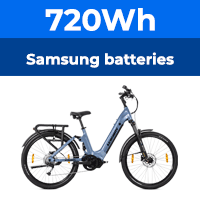Search results
-
M
Yet another London female cyclist dies
Anybody got the figures for other large UK cities? Do they also show the same disproportion of male/female deaths?- mike killay
- Post #24
- Forum: General Chat
-
M
Crank drive pedelecs: chain wear and maintenance
My main problem is the 11 tooth cog which hardly seems to last 50 miles.- mike killay
- Post #18
- Forum: Electric Bike General Discussion
-
M
Legality of power ratings
From what I can see of those tests, then yes you are right. All systems need a safe working load and it would be daft to fit a motor that performed at 250 watts but burned out at 251 watts. We know that the motors supplied by the Chinese have different markings to satisfy the various legislative...- mike killay
- Post #30
- Forum: Electric Bike General Discussion
-
M
Legality of power ratings
I may be quite wrong, but I get the impression that it is in fact the controller, not the motor that is important. A controller set to deliver no more than 7 amps at 36 volts will allow the motor to develop 252 watts. Up the amps and the wattage goes up. There is no such thing as a 250 watt...- mike killay
- Post #20
- Forum: Electric Bike General Discussion
-
M
Yet another London female cyclist dies
Flecc, do you know who this female Liberal MP is? I am quite willing to write to her Mike- mike killay
- Post #18
- Forum: General Chat
-
M
Crank drive pedelecs: chain wear and maintenance
It could be that the chain breaker itself is critical and it is necessary to ensure that the rivet is properly, fully pushed home evenly on both sides. I must confess that I did not check this point.- mike killay
- Post #11
- Forum: Electric Bike General Discussion
-
M
Kalkoff batteries again !
What is the hole above the split? Could it be simple mechanical damage?- mike killay
- Post #6
- Forum: Electric Bike General Discussion
-
M
Crank drive pedelecs: chain wear and maintenance
I have only ever had one chain snap. I am certain that it broke where I had joined the chain with a chain breaking tool. There was no sign of the rivet, it must have come out of both sides at once. Which leads me to, Should you ever use a chain breaking tool? Shimano insist that their chains...- mike killay
- Post #9
- Forum: Electric Bike General Discussion
-
M
Fake Reviews
I think that the danger is that if we leave a fake review in the forum, sooner or later, someone googling the name will come to the forum and read a glowing review of what we all know is a piece of junk.- mike killay
- Post #4
- Forum: General Chat
-
M
Sheared screw - help please!
A bike shop that cannot remove that bolt has no business calling itself a bike shop. Try a local garage.- mike killay
- Post #8
- Forum: Electric Bike General Discussion
-
M
Where is the 2 speed hub motor?
After the early reports in 2013, more in 2014, I expected the market to have a number of two speed motors in 2015- mike killay
- Thread
- Replies: 3
- Forum: Electric Bike General Discussion
-
M
Kalkhoff Pro Connect. Impressive range.
Is a narrower chain necessarily weaker? If the side plates and rivets are still the same size and thickness as a wider chain, I would think that the strength is the same.- mike killay
- Post #26
- Forum: Electric Bike General Discussion
-
M
Fold this bike in one second... Doubt it, but still handy though!
Seems to be a parts bin special. Differing batteries and controller boxes, Differing spoke patterns on the 18 inch wheels Headlights come and go- mike killay
- Post #5
- Forum: Electric Bike General Discussion
-
M
Difference between 250w vs 350w Bafang 8Fun hub motor
Getting complicated here. OP asks about Bafang 8 Fun motor. Replies are about BPM, SWX etc.- mike killay
- Post #4
- Forum: Electric Bike General Discussion
-
M
Bosch Nyon Issues?. New substantial update: Jan 2015
Boy, am I glad that both my Woosh and the Tonaro are fitted with simple magnet ring, throttle, bog standard controllers etc. It is almost as though the Bosh has been deliberately designed to keep LBS's in a steady supply of work.- mike killay
- Post #62
- Forum: Electric Bike General Discussion
-
M
Stick Carrier
I have carried a number of awkward long things such as fishing rods strapped with a sling, rifle fashion over one shoulder.- mike killay
- Post #10
- Forum: Electric Bike General Discussion
-
M
News :- Mando Footloose IM arrives in UK
What is like at hill climbing?- mike killay
- Post #2
- Forum: Electric Bike General Discussion
-
M
Tonaro Compy lost all power
I know that it sounds obvious, but I should check the battery, have you tried charging it? Could be that the battery is worn out, shows a full charge on static test, but cuts out when you try to draw serious power- mike killay
- Post #12
- Forum: Electric Bike General Discussion
-
M
Keeping battery healthy
I keep it topped up, even if only a little. 4 years down the road with my Tonaro battery and it seems as good as ever.- mike killay
- Post #8
- Forum: Electric Bike General Discussion


